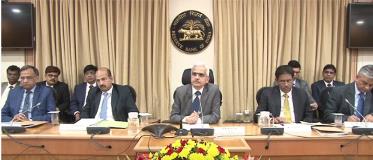Growth Concerns Remain Central as RBI Cuts Rates by 25 bps

The first indications of the slowdown in growth were already there when the August policy was announced but there have been a lot of critical data points that came out post the August policy which hint at pressure on growth. GDP growth for June quarter came in at just 5%. The core sector growth was in a steady downtrend and actually dipped into negative growth of (-0.5%) in August 2019. IIP has also been touching multi-month lows even as PMI Services dipped sharply below 50, showing contraction in this segment. It is therefore hardly surprising that RBI has made growth the central theme of the October monetary policy.
Highlights of the October Monetary Policy
-
The repo rate has been cut by 25 basis points from 5.40% to 5.15%. This is the fifth consecutive rate cut since February and the RBI has already cut rates by 135 bps this year.
-
Since the reverse repo and MSF raters are linked to the repo with a 25 basis points spread either ways, they stand reduced to 4.90% and 5.40% respectively.
-
The MPC has retained the stance of the policy as accommodative and committed to it till growth pressures remain and inflation is within the range of 4% (+/- 2%) range.
-
All six members of the MPC voted for Accommodative stance and to cut rates. Dr. Dholakia voted to reduce the rates by 40 bps but other five members voted to reduce rates by 25 bps, which was eventually the majority verdict.
-
The detailed minutes of the monetary policy will be announced on 18th October and the next meeting of the MPC will be held on 5th December, 2019.
Economic context of the policy announcement
The economic context can be gauged from the fact that the growth rate for fiscal 2019-20 has been downgraded from 6.9% to 6.1%, one of the sharpest outlook cuts between two policies. RBI also expects the September quarter GDP growth at 5.3% and the GDP will have to grow at closer to 7% in the last two quarters for the full year GDP to be able to touch 6.1%. Growth, definitely, remains the million dollar question for the RBI.
The policy has expressed conviction that the cut in corporate tax rates to 22% and the tax rate for fresh investments to 15% would help boost consumption and investments. However, currently there is a big negative output gap and this rate cut will complement the tax cuts to bridge the output gap. Most of the high frequency growth indicators like GDP, IIP, Core Sector, PMI Manufacturing and PMI Services have been under strain.
In the past, the RBI has been wary of cutting rates in the midst of rising inflation. But RBI does not see any major upside risks to inflation. The median rate of 3.2-3.5% is expected to hold. Broadly, Kharif output has been at par with the previous year, albeit marginally lower. But the buffer stock of pulses is expected to keep prices in check. The bottom line is that even as weak growth remains a challenge, the tepid inflation may support a cheap money policy.
Will markets really be impressed by the rate cut?
To be fair, the 25 bps rate cut was already anticipated and factored into prices. There is little by way of positive surprise here. Also the markets are unlikely to be pleased with the growth outlook considering that the RBI has downgraded the growth projection from 6.9% to 6.1% for the full fiscal. Also, the RBI projection of 5.3% for the second quarter is much lower than all previous estimates. The RBI has also put the pressure on banks to improve their transmission ratio from the current 25% to a much higher level. Markets are also sceptical that this would mean pressure on banks and financials that account for 41% of the Nifty weight. These are some of the key challenges that are likely to make markets cautious.
Some parting thoughts on the policy
While we wait for the detailed minutes, it must be acknowledged that the RBI has moved the policy beyond rates and liquidity. For example, the policy has made an attempt to expand market eligibility for MFIs to participate. It has also permitted rupee derivatives with delivery to be traded on the IFSC. RBI will extend collateralized liquidity support on all NEFT days once it goes live in December 2019. Above all, the policy has also spoken about create a special fund to expand digital infrastructure.
Start Investing in 5 mins*
Rs. 20 Flat Per Order | 0% Brokerage

